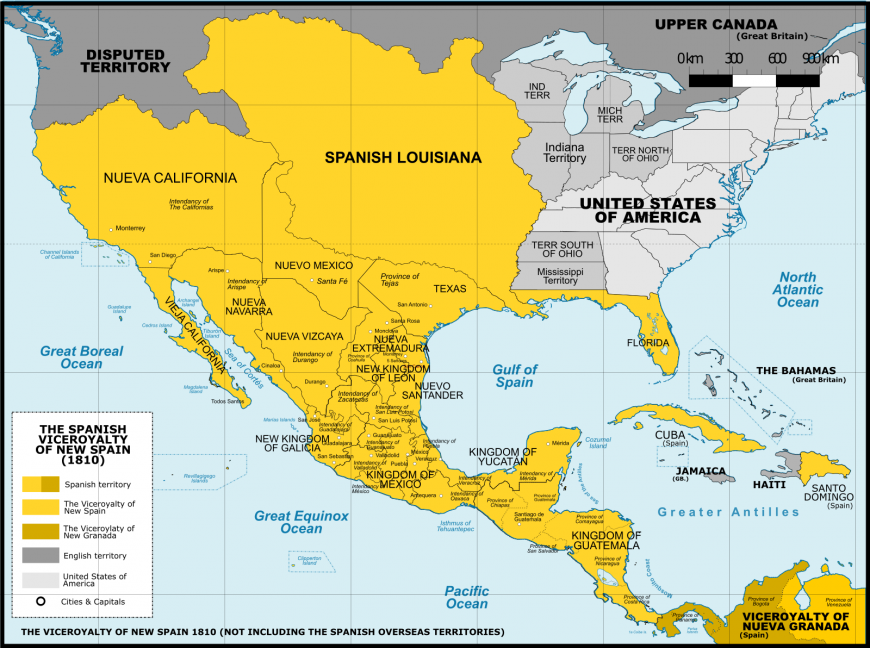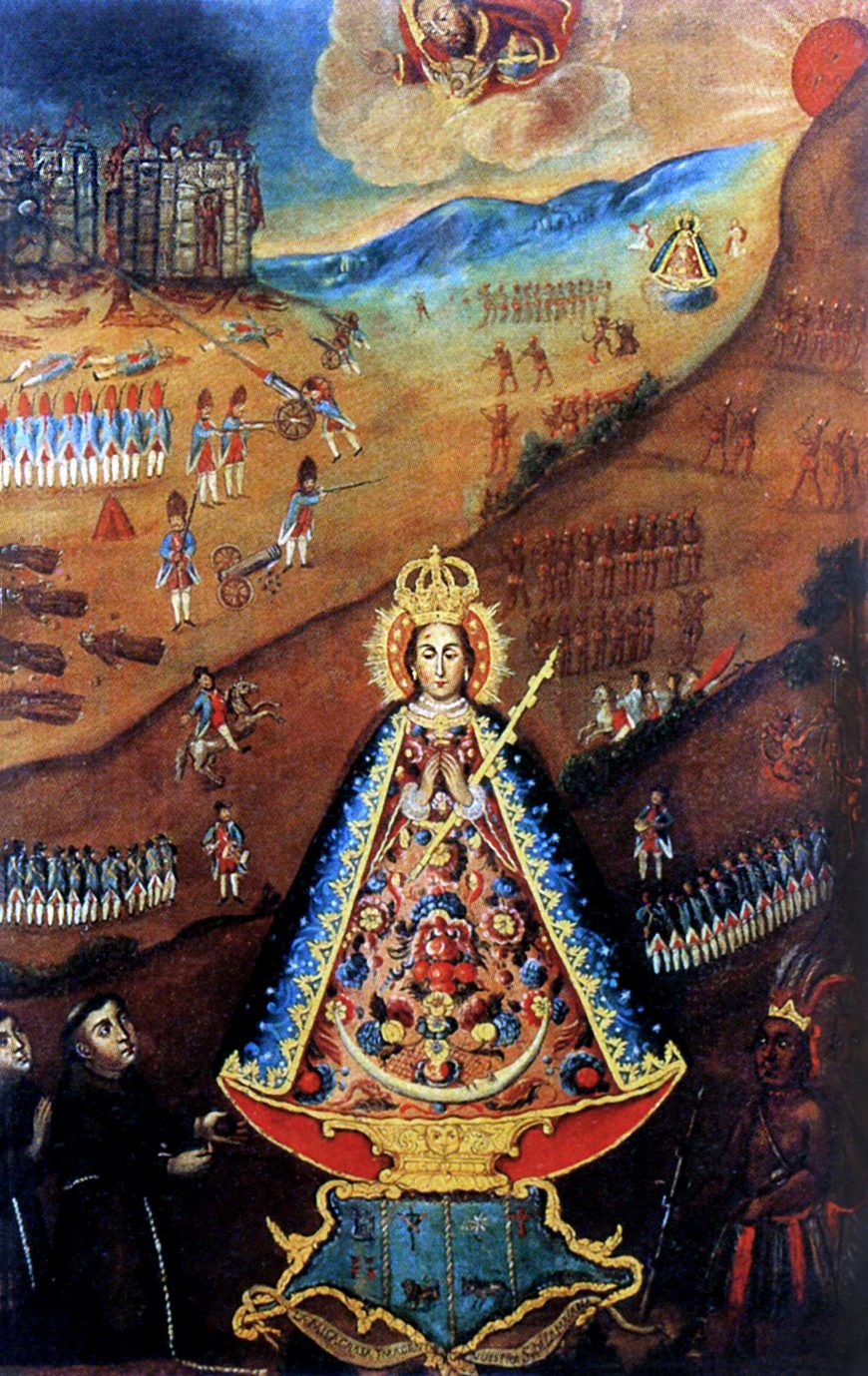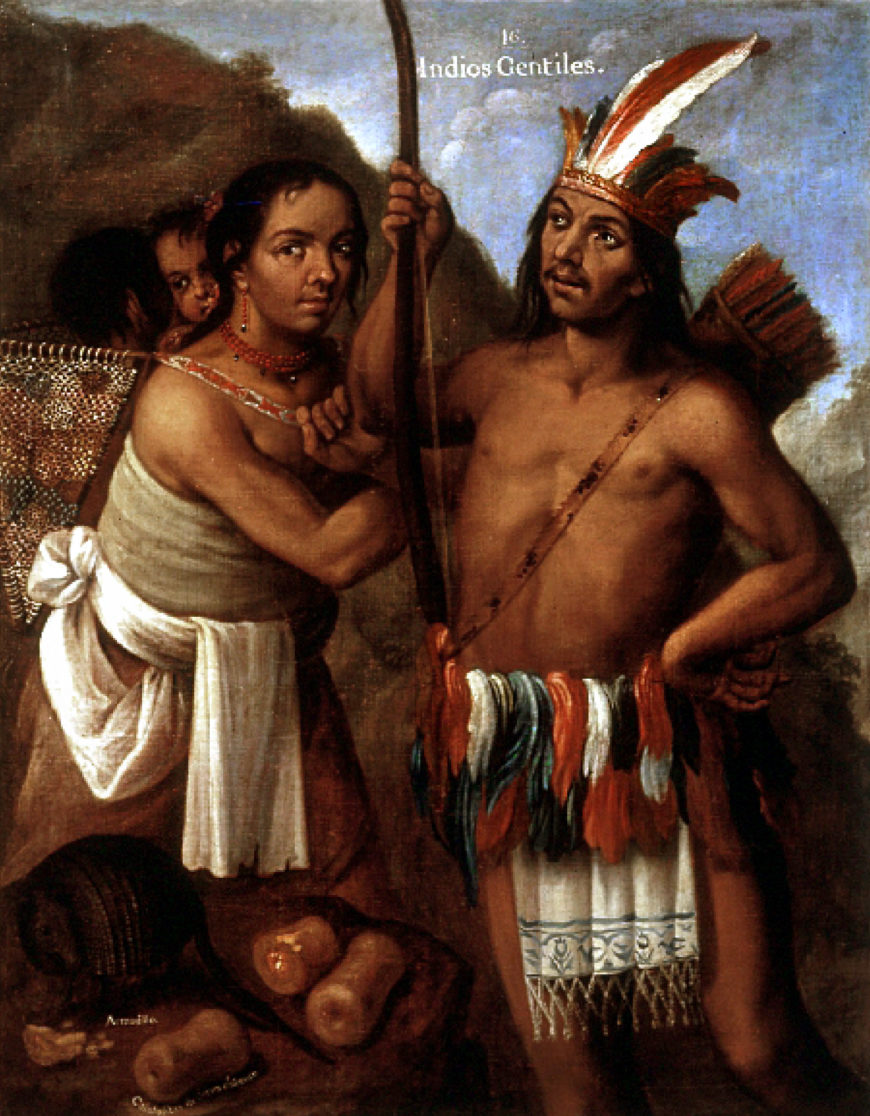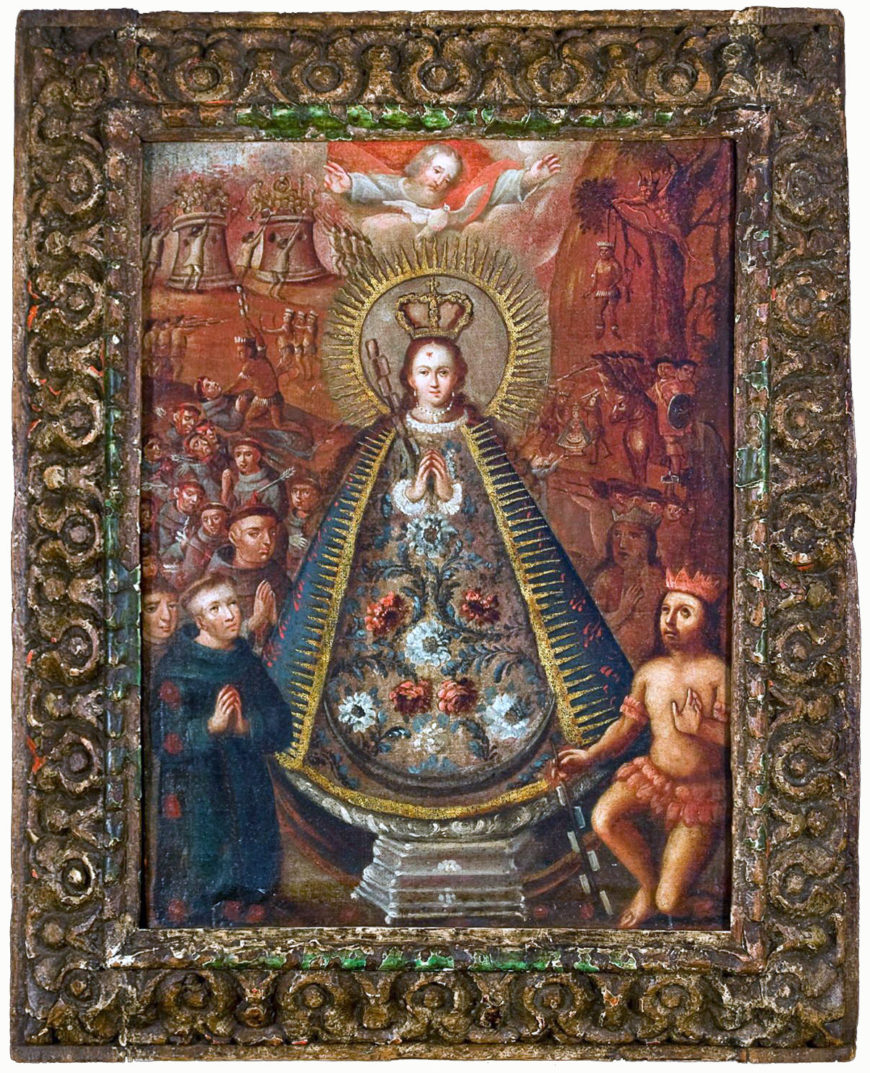
The Virgin of the Macana, second half of the 18th century, oil on canvas (History Collections New Mexico History Museum)
Did you know that the first American Revolution took place in New Mexico? The Pueblo Revolution, better known as the Pueblo Revolt of 1680, was the only successful Indigenous insurgency (armed rebellion) to expel Spanish colonial forces in the Americas (Spanish colonization began in 1492 when Christopher Columbus landed on the island that would become Hispaniola). In the 17th century, New Mexico was part of the northern frontiers of the viceroyalty of New Spain, where Spanish control was continuously contested by Native groups and other European powers. The Pueblo Revolution involved Christianized Pueblo peoples and non-Christian Apaches rising up against the Spaniards, killing 21 Franciscans and almost 400 Spanish colonists. The thousands of remaining colonists were forced to flee.
The Pueblo Revolution was a monumental event during which the Native Pueblos of New Mexico regained their independence for twelve years. Despite this, no artists of the period depicted this event, though Spaniards (whose goal was to justify their control of these lands and people) did write about it. It is only in later 18th-century images, such as the The Virgin of the Macana now in the New Mexico History Museum, that help us learn more about this important historical revolution and how artists chose to depict it.
The paintings
Only a few paintings of the Virgin of the Macana (also called just Macana) still exist, and they all date to the second half of the 18th century. They all display remarkably similar iconography: Mary is shown as a statue, bleeding from her forehead, wearing a crown, and holding a macana (a wooden weapon embedded with obsidian blades commonly used by the Nahua peoples of central Mexico—not by the Pueblo peoples in New Mexico). She is surrounded by events from the Pueblo Revolution.
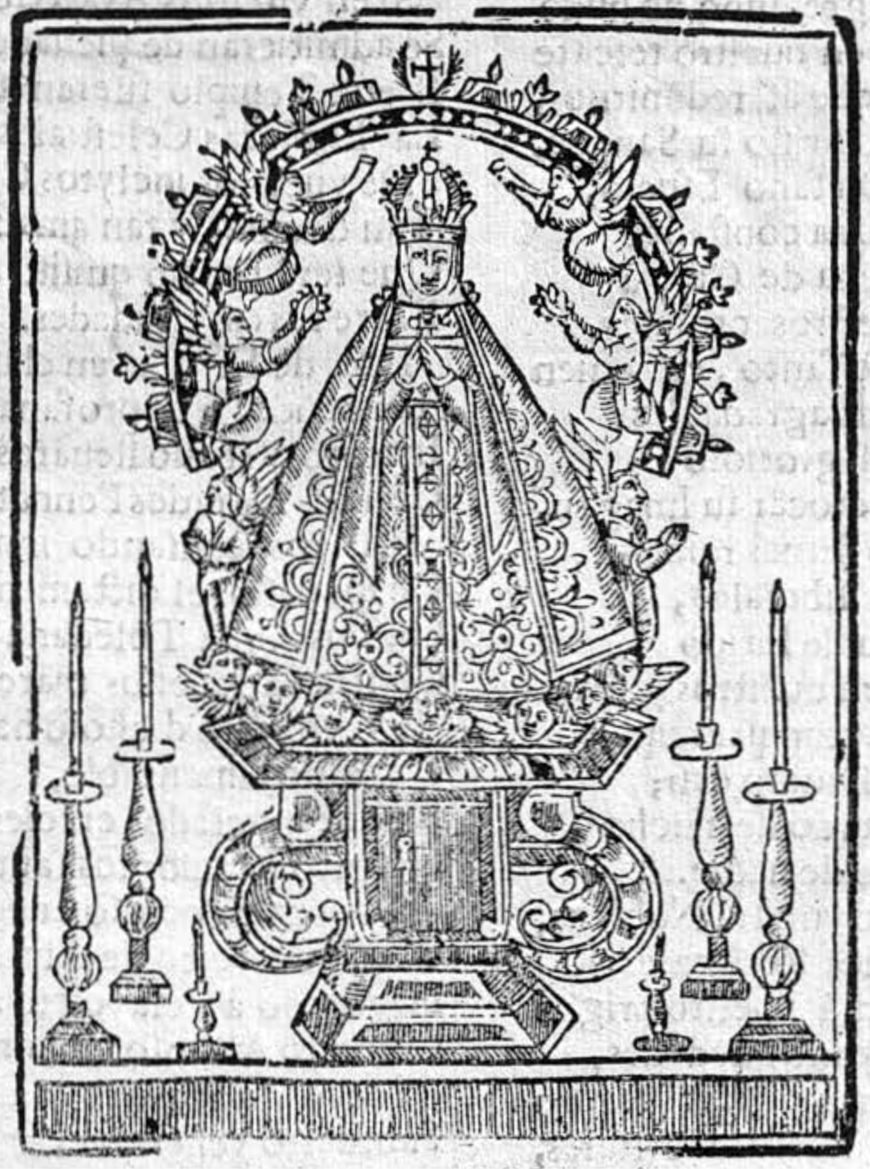
The Virgin of Toledo, the printed frontispiece to A la devocion que la Reyna nuestra señora ha significado a la imagen de la Madre de Dios, que con titulo del Sagrario se venera en la muy Santa Iglesia de Toledo, Primada de las Españas (Madrid, 1677) (Biblioteca Nacional de España)
With the Spanish conquest and colonization of the Americas, devotions to and images of the Virgin Mary, Jesus, and saints were transported across the Atlantic Ocean, where they were then adapted to the historical and regional peculiarities of the Spanish colonies. Paintings and prints showing statues (called “statue paintings”) were a popular genre in Spain that was brought to the Spanish viceroyalties. One example is a copy of a statue of the Virgin of Toledo (Nuestra Señora del Sagrario de Toledo), which was brought to New Spain by Franciscan missionaries who viewed Mary as their protectress while they established missions and converted Indigenous peoples. This statue of the Virgin of Toledo would be recast as the Virgin of the Macana (with the addition of the scar and a weapon) in New Mexico a century after the Pueblo Revolution.
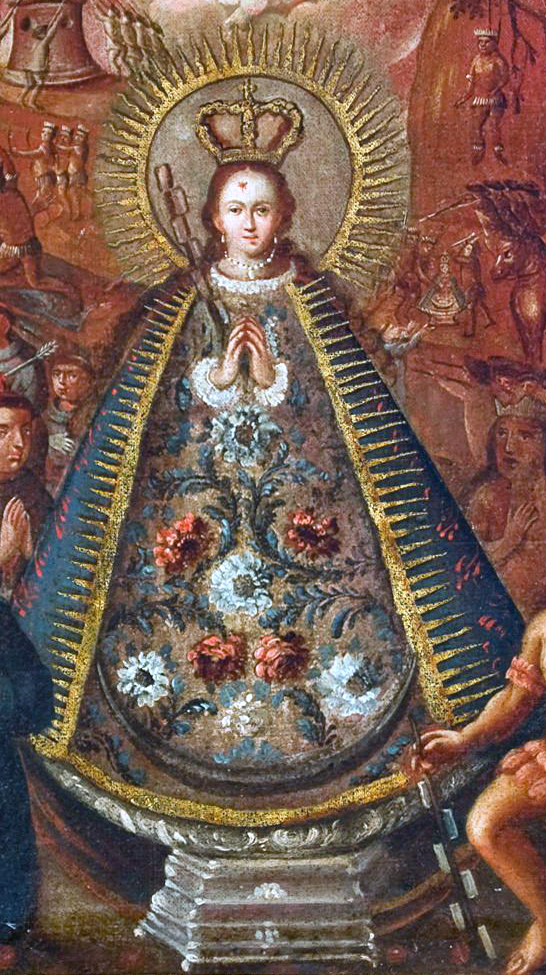
The Virgin of the Macana (detail), second half of the 18th century, oil on canvas (History Collections New Mexico History Museum)
In the painting of Macana in the New Mexico History Museum, the statue of Mary dominates most of the composition. Mary is identifiable as a statue because a pedestal is visible beneath her. We also see a crescent moon at the base of the statue; Mary is often shown standing on a crescent moon (as a reference to her purity and immaculate conception), but here her feet are absent. She wears a blue mantle and an elaborate dress covered in flowers. The dress flares outwards to create a pyramid shape, adding to the impression that this is a painting of a statue. We get no sense of her body underneath. Statues such as this would have been carved in wood, then painted. Additional clothes and jewelry (that could be swapped out) would have further enlivened it.

The Virgin of the Macana, second half of the 18th century, oil on canvas (History Collections New Mexico History Museum)
In the painting, she is flanked on either side by two kneeling figures, a Franciscan friar (to our left) wearing a blue habit and an Indigenous man (to our right) wearing only a headdress, two arm bands, and a feathered loincloth. The man on the right steadies himself with a macana. Both men look up at Mary. The friar and the Native man are not specific individuals—they are generic types that represent the two main groups (Spaniards and Puebloans) that fought one another during the Pueblo Revolution. The kneeling Franciscan missionary also represents the Franciscan friars who had come to the northern frontier of New Spain, and who were killed during the Pueblo Revolution.
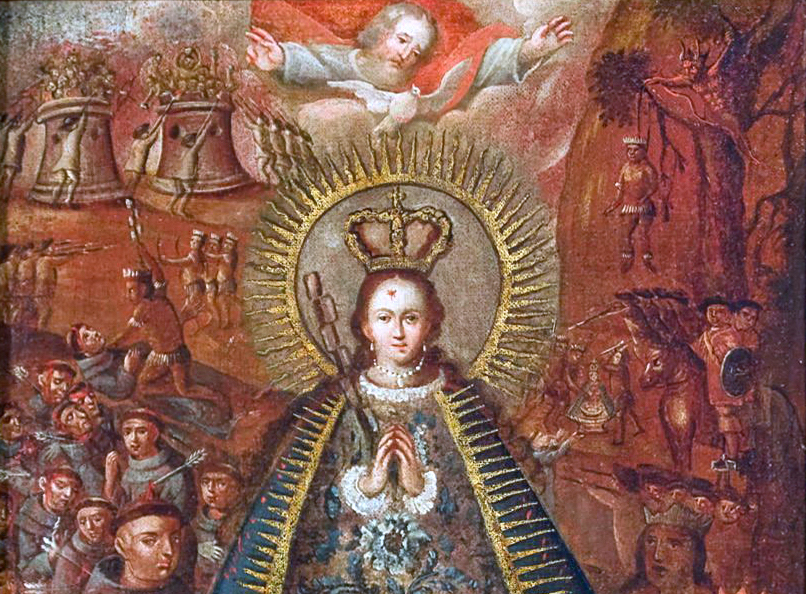
The Revolution (detail), The Virgin of the Macana, second half of the 18th century, oil on canvas (History Collections New Mexico History Museum)
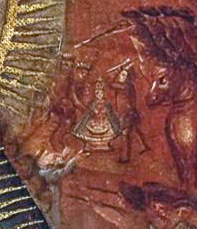
Detail of Indigenous people attacking the statue. The Virgin of the Macana, second half of the 18th century, oil on canvas
Behind them, a chaotic battle scene plays out. On the top left, Native peoples throw stones against the Spanish army from defensive towers as the Spanish troops fire guns at them. Below, an Indigenous person raises a macana to strike a friar. We also see mutilated Franciscans, many of them with wounds on their heads and arrows through their hearts. The foreground of the painting presents the idea that the Pueblo people who revolted were “barbarians” who killed innocent and unarmed Franciscans.
On the right side of the painting, we see more fighting, with Spanish forces pointing guns and riding in on horses to stop the rebellious Natives. We also see Pueblo peoples attacking the statue of the Virgin of Toledo, and a Native man hanged in a tree in the upper right. Above all this violence, we see God the Father and the Holy Spirit, both framed by clouds.
Questions remain: why did the Pueblos rise against the Spaniards? And why are the Pueblo peoples shown as violent, barbaric aggressors in this painting? Whose version of events do we see here?
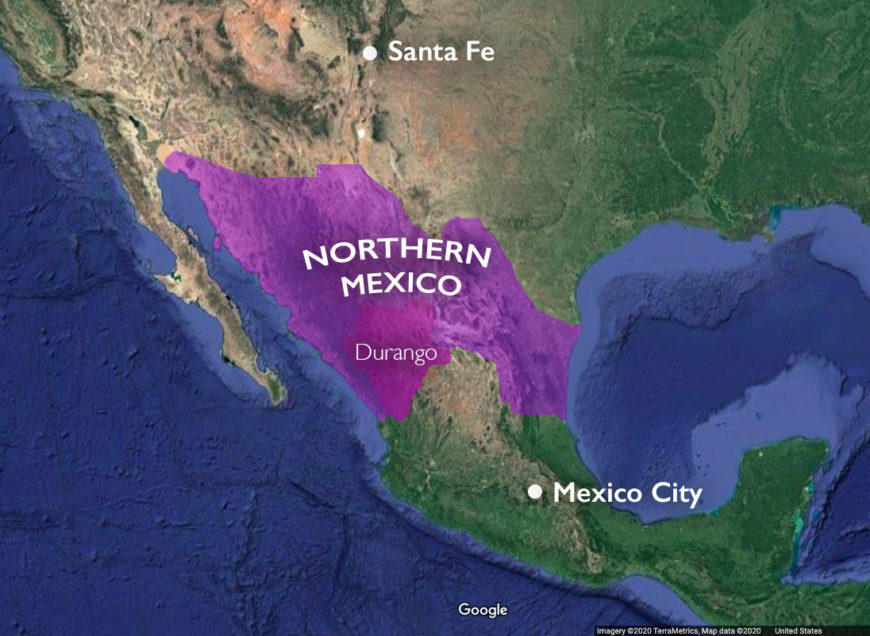
Map showing the general locations of Indigenous uprisings in northern provinces of New Spain (underlying map © Google)
Native resistance
The history of the Americas under the Spanish is marked by a series of often violent encounters between Native peoples and Castilians (as the Spanish knew themselves). If we are to understand this history more fully, we must re-contextualize colonial history to include the series of Indigenous resistance movements that constantly challenged Spanish authority in the territories they administrated. The Pueblo Revolution was only one of many Native uprisings in the northern provinces of New Spain during the 17th century. These included (unsuccessful) uprisings from the Tepehuanes (1616–1620, in present day Durango), Tobosos, Conchos, and the Tarahumaras (1644–1652, in present day northern Mexico), all of whom responded to mistreatments from colonial authorities.
The groups who today identify as Pueblo peoples (in what is today the southwestern United States) shared similar religious beliefs, and a similar visual and material culture, but their languages and customs varied and historically, the Pueblo peoples did not see themselves as part of a unified ethnic group. After the Revolution of 1680, however, a shared sense of regional pride and unity developed as a strategy to keep the Spaniards away from their lands.
The Franciscans and the conversion of the Pueblo peoples
When the Spaniards founded the village of Santa Fe in 1607, the spiritual conquest of the local Pueblo peoples was entrusted to the Franciscans, a religious order that had arrived early on in New Spain, following closely the initial Spanish conquests of central Mexico. The Franciscans began to convert Indigenous peoples to Christianity, and worked throughout the Americas to eliminate what they believed were the idolatrous beliefs of the Native populations. They saw it as their duty to defend what they believed to be the true religion, Christianity. Images such as The Virgin of the Macana, with its depiction of Native people attacking a representation of the Virgin Mary demonstrate how Europeans justified colonization by depicting Native resistance as an attack on their faith.
Under the religious zeal of the Franciscans, Pueblo peoples and their traditions were continuously targeted. Violent colonial practices resulted in severe corporal punishment for many activities including the refusal to observe the Spanish prohibition of Native ceremonial dances. The Spaniards also carried out the near total destruction of Indigenous religious centers and the sacred objects of their worship. Official Spanish accounts of this period focus not on the injustices suffered by Indigenous people, but instead on Native assaults on Spanish authority.
The legend of the Virgin of the Macana
A text written shortly after the Pueblo Revolution helps us to better understand the iconography of paintings of the Virgin of the Macana and how it reflects the Franciscan perspective of the Pueblo Revolution. The Franciscan chronicler Friar Agustín de Vetancurt wrote about the origins of the Virgin of the Macana in his book Teatro mexicano (1698), and later 18th-century artists borrowed from this account to create their images of Macana. Published a few years after Spanish control was restored over the Pueblos (which occurred in 1692), Vetancurt drew information from funeral orations honoring the fallen Franciscans and historic accounts as told by Spanish soldiers including the Spanish Governor of Santa Fe during the Pueblo Revolution.
According to Vetancurt, a copy of the statue of the Virgin of Toledo originally came to New Mexico with Franciscans sometime after the conquistador Juan de Oñate y Salazar intruded into the area in 1598. They had brought the statue from Spain as protection during their mission and it was also intended to signal to local Pueblo peoples that Spanish forces were powerful because Mary watched over them.
Vetancurt’s story details how a few years before the Pueblo Revolution, the Virgin of Toledo appeared to the six-year old daughter of the Spanish governor. The Virgin miraculously cured the girl of a physical ailment, and then cautioned her to warn her father and local administrators against the injustices they had committed against the Pueblo peoples for almost a century. She also requested that the Franciscans be treated better by Spanish administrators (there were ongoing tensions between political colonial administrators and the Franciscan missionaries at this time). If the abuses of either group continued, the Virgin of Toledo warned, the conquistadors would be punished. The Virgin is quoted as saying:
Raise thyself child, and tell that this province will soon be destroyed for the lack of reverence that it shows my priests, and that this miracle will be the testimony of this truth; that they mend their ways, should they not want to experience punishment. [1]
In other words, the apparition was supposed to be a wake-up call to local government authorities. Yet those cautioned ignored her call, and six years later, the Pueblo Revolution occurred.

Detail of the Virgin’s face with the wound. The Virgin of the Macana, second half of the 18th century, oil on canvas
According to legend, during the Revolution a Native struck the forehead of the statue of Our Lady of Toledo in an attempt to destroy it, creating a wound that was visible on the statue. From the Spanish perspective, Macana’s survival was miraculous. The statue survived the Revolution largely unscathed at a time when other churches and Christian images were destroyed. In painted versions of Macana, the wound is visible on the statue to remind viewers of this miraculous moment.
This violent act transformed the statue of the Virgin of Toledo into the Virgin of the Macana; she was given the macana to hold. Here, the statue’s forehead wound represents Native violence, and more importantly, Christian triumph over the “barbarian.” A Native weapon transferred to the hands of the Virgin became a powerful Christian emblem that legitimized the Spanish campaign against Native people and their perceived idolatry (which the Spanish believed was aided by the Devil). In this way the Macana also undermined the legitimacy of the Pueblo Revolution despite the warning of the Virgin to the daughter of the Governor. After the Revolution, the statue was moved to Mexico City, and, after 1754 was housed in the main Franciscan convent of San Francisco where it is still venerated to this day (although the statue today is possibly not the original). [2]
Franciscan martyrdom
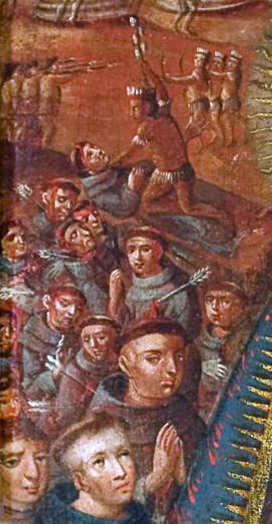
The Virgin of the Macana (detail), second half of the 18th century, oil on canvas (History Collections New Mexico History Museum)
In paintings of Macana, Indigenous people attack and kill Franciscans. From the Franciscan perspective, these men died as martyrs—in other words they died for their Christian faith. Paintings, like the version in the New Mexico History Museum, show the martyr-making process that was desired by the members of the Franciscan order. Those who died through the violent acts of barbarian heathens (as they understood it) echoed Christ’s death at the hands of the pagan Romans.
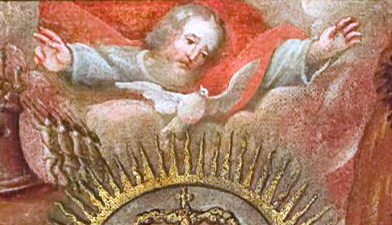
The Virgin of the Macana (detail), second half of the 18th century, oil on canvas (History Collections New Mexico History Museum)
The inclusion of God and the Holy Spirit at the top of the painting suggests the divine destiny of the twenty-one Franciscans who were martyred during the uprising. God holds his arms open, blessing the Virgin Mary and the martyrs in the chaotic scene below.
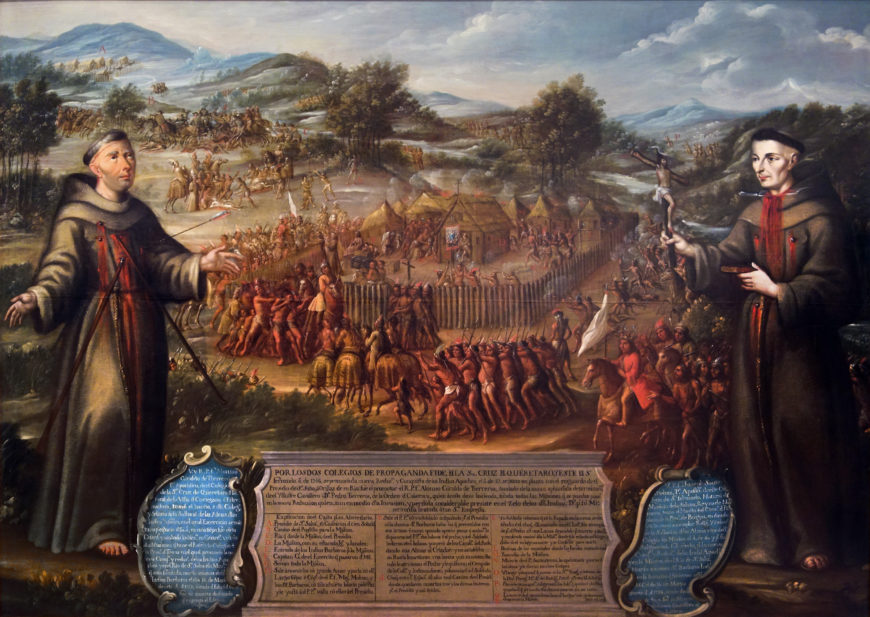
Attributed to José de Páez, Destruction of the Mission of San Saba in the Province of Texas, and Martyrdom of Fray José de Santiesteban and Fray Alonso Giraldo de Terreros, ca. 1758–1765, oil on canvas, 82.5 x 115 in (Museo Nacional de Arte, Mexico City)
Paintings of the Virgin of the Macana relate to another genre of images that were popular in the later viceregal era: Franciscan martyr portraits, such as one attributed to José de Páez displaying the friars José de Santiesteban and Alonso Giraldo de Terreros who were killed at the Mission San Saba in Texas. These types of portraits typically depict the individuals killed, along with smaller scenes showing their violent death at the hands of Indigenous peoples. Inscriptions detail the events of the martyrdom and the biography of the martyr. Like paintings of Macana, martyr portraits foregrounded missionaries dying as a result of Native violence and visually eliminated Indigenous struggles under Spanish subjugation. Images showing Franciscan martyr narratives were common in monastic spaces because they were thought to inspire future missionaries who might die on the northern frontiers of New Spain.
Images of Macana were intended for a Franciscan audience. They functioned as a powerful testament to the Franciscan mission to convert Native peoples at a time when Spanish administrators felt the religious order was failing. This helps to explain why an event from the late 17th century was an important subject in the later 18th century, and why we do not have a larger number of paintings (as we do for other miraculous Marian apparitions such as the Virgin of Guadalupe). The legend of Macana, as portrayed here, served a specific Franciscan agenda.
“Devout Indians” and “Barbarians”
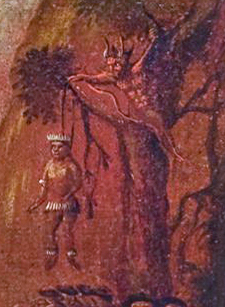
Detail of hanged man and the Devil. The Virgin of the Macana, second half of the 18th century, oil on canvas
In paintings of the Virgin of the Macana, we see two types of Indigenous people: the violent barbarians who kill the Franciscan friars and pious Indigenous figures who kneel before the Virgin Mary, reformed of their violent habits. In Vetancurt’s book, he claims the Devil advised Pueblo peoples to engage in the violent insurrection. In other scenes, violent “barbarians,” driven by un-Godly motives, attack the Franciscans as well as the Marian statue. In their attacks, they wield the macana, a weapon, as previously noted, that wasn’t used by the Pueblo peoples. This was a means to underscore the trope of the barbarian—historical accuracy wasn’t important. The devil himself actually makes an appearance in the painting, holding the rope by which the Native man is hanged (even as the Devil is understood to have encouraged the revolt). The hanged man is represented as the man who struck the statue of the Virgin in the scene directly below this one.
In Colonial Spanish American art, the “barbarian” was commonly represented half-naked, wandering through rural settings, and in need of spiritual intervention. From early 16th-century maps and prints of the Americas showing bands of naked cannibals to 18th-century casta paintings (such as a panel by Miguel Cabrera showing indios genitles) depicting nomadic tribes at the edges of the empire, the iconography of the uncivilized “barbarian” remained popular throughout colonial visual culture (as well as in Europe).

Attributed to José de Páez, Destruction of the Mission of San Saba in the Province of Texas, and Martyrdom of Fray José de Santiesteban and Fray Alonso Giraldo de Terreros, ca. 1758–1765
One aspect of these paintings did change over time. The locations in which Natives were represented. In the early 1500s, images of Indigenous people were located in places like Central Mexico where the Spaniards had defeated the powerful Mexica Empire. Representations of “barbarians” were enlivened with careful renderings of plants, natural topographic features, and animals found in this region. After the success of the Pueblo Revolution, artists began to show Natives on the edges of the Spanish empire—in Texas, New Mexico, and California (such can be seen in José de Páez’s martyr portraits of friars José de Santiesteban and Alonso Giraldo de Terreros in Texas). Such paintings were used as visual evidence of the need for tighter colonial administration of these areas.
In The Virgin of the Macana, the miraculous intervention of the Virgin Mary transforms the uncivilized, violent Native into one who is subdued and converted to Christianity, here symbolized by the Native men kneeling beside her in the foreground. The “devout Indian” became a common trope throughout the 300 years of Spanish control in the Americas and was intended to show the successful conversion of Native peoples. Showing Native peoples before and after Christian conversion emphasizes the power of the Virgin’s intervention during the Pueblo Revolution, and by extension, the success of the Franciscan mission system in New Mexico.
Revolutionary Images
Colonial paintings of the Virgin of the Macana are important because they reveal the process in which Franciscans obscured Indigenous discontent by rendering Native groups as violent savages with no justification for their resistance. Vetancurt’s account and the later images of the Virgin of the Macana focus on Pueblo violence and idolatry, and reference the tense political environment in late 17th-century New Mexico. The representation of Native resistance, spiritual conquest, and the triumph of Catholic dogma underline the extraordinary effort undertaken to convert Native Peoples. However, re-contextualizing devotional paintings such as The Virgin of the Macana in the New Mexico History Museum to include a less biased history of the Pueblo Revolution makes it possible to visualize alternatives readings of the violence against Native people, as well as their historic resistance.
Notes:
[1] Augustín de Vetancurt, Teatro mexicano: descripción breve de los sucesos ejemplares de la Nueva-España en el Nuevo Mundo Occidental de las Indias (Madrid: J. Porrúa Turanzas, 1960), 103.
[2] Antonio García Cubas, El libro de mis recuerdos: narraciones históricas, anecdóticas y de costumbres mexicanas anteriores al actual estado social, ilustradas con más de trescientos fotograbados (Mexico City: Imprenta De Arturo Garcia Cubas, 1904), p. 64.
Additional resources
Ilona Katzew,“The Virgin of the Macana: Emblem of a Franciscan Predicament in New Spain,” Colonial Latin American Review 12, no. 2 (2003): pp. 169–198
Luisa Elena Alcala, “The Images of the Devout Indian: The Codification of a Colonial Idea,” Contested Visions in the Spanish Colonial World, ed. Ilona Katzew (Los Angeles: LACMA, 2011)
Images of the Natives in the Art of New Spain, 16th to 18th centuries (Mexico City: Banamex, 2005)
Learn about Columbus’ Landing and Erasing Native Resistance with the project Unsettling Journeys
Emmanuel Ortega, “Hagiographical Misery and the Liminal Witness: Novohispanic Franciscan Martyr Portraits and the Politics of Imperial Expansion,” in Visualizing Sensuous Suffering and Affective Pain in Early Modern Europe and the Spanish Americas, ed. Lauren G. Kilroy-Ewbank and Heather Graham (Leiden: Brill, 2018), pp. 234–65.

